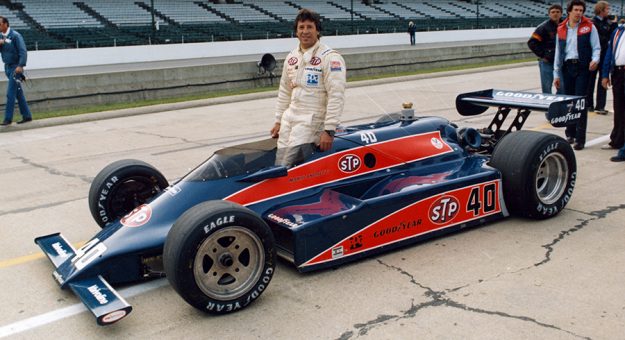INDIANAPOLIS — There was a time when he was the ultimate cosmopolitan sportsman, recognized on several continents, celebrated at every turn.
The world was his, and Mario Andretti, race driver, was seeing it in style.
“I was Concorde’s most frequent traveler, 26 crossings in a year,” Andretti told English writer Simon Taylor. “The ground staff were always ready for me, had my Financial Times and my brioche waiting.”
He had won the Daytona 500 in 1967, the Indy 500 in ’69, and in 1978 he’d been Formula One champion. Do all that, and the world will show you the sweet life.
Ah, but what goes up must come down. For Andretti, la dolce vita soon morphed into la dura vita: the hard life. His F-1 fortunes began to change when Team Lotus replaced his title-winning thoroughbred with a beautiful nag. Its chassis flexed, twisted and groaned, and after only three outings in 1979, Andretti reverted to his previous year’s mount.
That 1978 car had ushered in Grand Prix racing’s ground-effects era. But now it was as if every Brit and European with access to a drafting table had outwitted the mad Lotus scientist, Colin Chapman.
Ferrari, Williams and Ligier were a giant step ahead. In 1979, Andretti stood on a podium just once, and didn’t lead a lap all year. The next Lotus also flopped. In 14 races across the 1980 season, Andretti scored one point. One.
Enough was enough. His contract with Chapman had run its course, and so had Mario’s attraction to Lotus. But jumping to Alfa Romeo for 1981 fixed nothing; after a fourth in the Long Beach opener, things slid downhill. Thirsty for victory, Andretti made several Indy car starts in 1979 and ’80, but won only once.
Which brings us to May of 1981, the month that broke Andretti’s wanderlust. Lord, has it really been 40 years?
That particular May had five weekends. On the first came the San Marino Grand Prix in Imola, Italy; the second weekend was reserved for Indy 500 qualifying, but rain spoiled Mario’s chances of running; on the third weekend, he took part in the Belgian Grand Prix while Wally Dallenbach unretired to qualify Andretti’s Patrick Racing entry at Indianapolis; weekend four meant the 500; the fifth and final weekend brought the Monaco Grand Prix.
You can picture Andretti half-grinning when he told F-1 wordsmith Nigel Roebuck, “It got to a point where I woke up in the morning, looked at the ceiling and thought, ‘Jeez, where am I? The Speedway Motel or the Hotel de Paris?’”
The joke there was that Monte Carlo’s Hotel de Paris was chic elegance, while Indy’s Speedway Motel was motor-court Americana. You’d have to be a special kind of tired to confuse the two. Get the point?
Mario’s best chance at glory that month — that year — was at Indianapolis. Instead, he became part of the most hotly debated result in the history of the 500.
You know the basic story: Bobby Unser, driving for Roger Penske, had the day’s dominant car, and finished first by an Albuquerque mile. But come Monday morning, Patrick Racing manager Jim McGee woke his driver with some news: USAC steward Tom Binford had penalized Unser one position for passing as many as nine cars, under caution, while exiting the pits on lap 149.
McGee also told Mario that he’d be needed at the track shortly for the customary morning-after photos of the winner.
Posing for those photos, Andretti looked like a man who didn’t know how to feel. Although he insisted that Unser’s pit-exit larceny was improper, he likely knew this victory would forever be tagged with an asterisk. Maybe he also recalled passing two or three cars that same way himself on lap 149.
Had officials penalized Unser at that time, rather than acting only after they saw his audacious move on film, the 1981 Indy 500 might be remembered as a classic race. No other car could touch Unser’s for sheer speed, so he could have rebounded to win anyway.
That was one of the arguments Penske brought to the USAC appeals board, which took until Oct. 9 to reverse Binford’s call and hand the Borg-Warner trophy back to Unser.
The whole thing created tension between Andretti and Unser, who had long been close pals. So you can add the bickering over the 500 and a rift with a dear friend to the load Andretti was carrying in 1981.
Back in May, in an Indianapolis press conference, he’d said, “I hope that in the not-too-distant future, I can come here and not worry about going (back and forth) to Europe. I’ll burn my passport.”
He never set his travel documents ablaze, but at season’s end he called time on his Formula One career. He was 41 years old; a very fit 41, to be sure, but 41, nonetheless. No man, not even the great Mario Andretti, is immune to the laws of nature, from aging to jet lag.
Yet once he ended his transatlantic race-chasing, he seemed to put nature on hold. Andretti raced for 13 more seasons and grabbed 18 more Indy car wins. La vita era di nuovo dolce. Life was sweet again.
